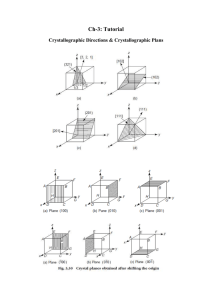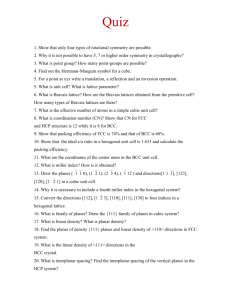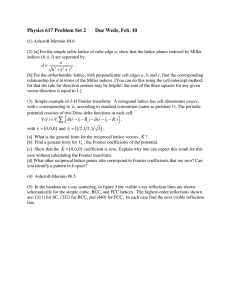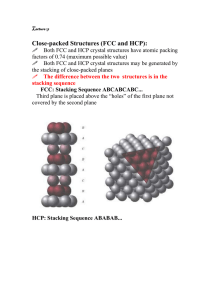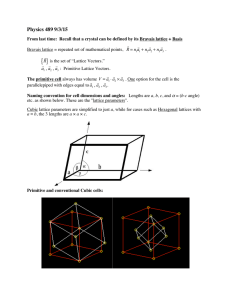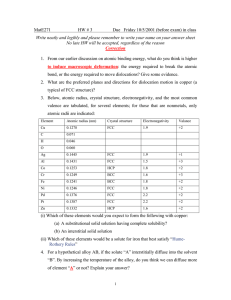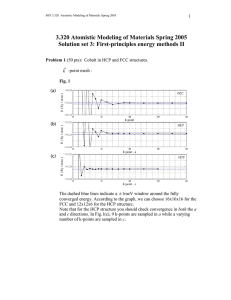3.320 Atomistic Modeling of Materials Spring 2005
advertisement
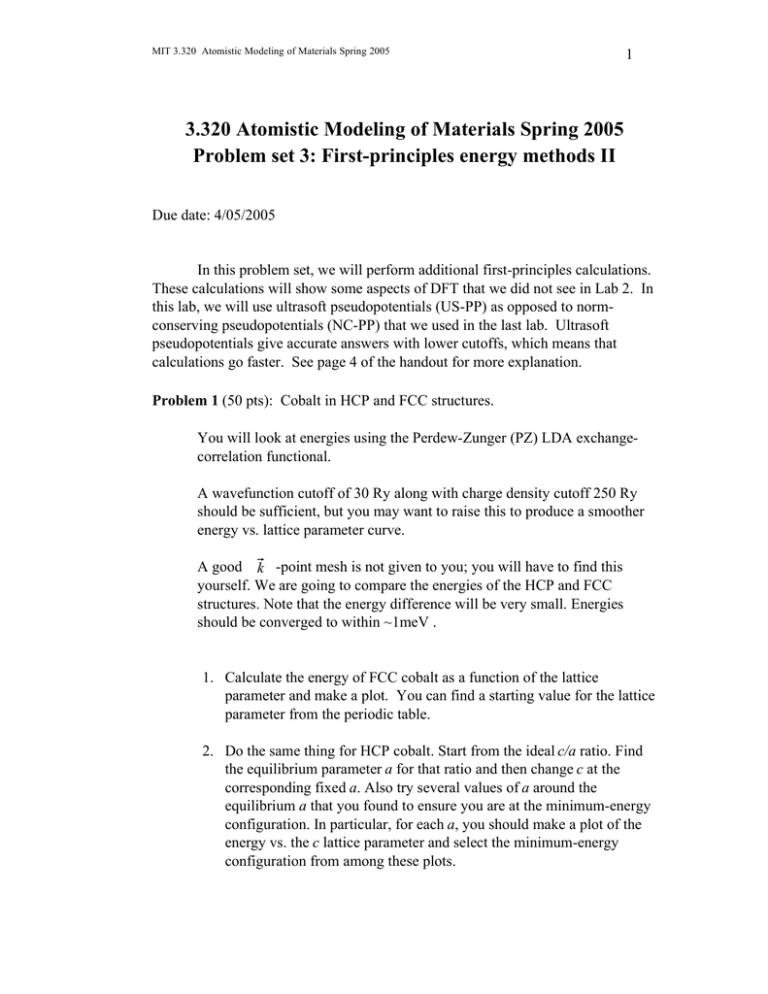
MIT 3.320 Atomistic Modeling of Materials Spring 2005 1 3.320 Atomistic Modeling of Materials Spring 2005 Problem set 3: First-principles energy methods II Due date: 4/05/2005 In this problem set, we will perform additional first-principles calculations. These calculations will show some aspects of DFT that we did not see in Lab 2. In this lab, we will use ultrasoft pseudopotentials (US-PP) as opposed to normconserving pseudopotentials (NC-PP) that we used in the last lab. Ultrasoft pseudopotentials give accurate answers with lower cutoffs, which means that calculations go faster. See page 4 of the handout for more explanation. Problem 1 (50 pts): Cobalt in HCP and FCC structures. You will look at energies using the Perdew-Zunger (PZ) LDA exchangecorrelation functional. A wavefunction cutoff of 30 Ry along with charge density cutoff 250 Ry should be sufficient, but you may want to raise this to produce a smoother energy vs. lattice parameter curve. A good k -point mesh is not given to you; you will have to find this yourself. We are going to compare the energies of the HCP and FCC structures. Note that the energy difference will be very small. Energies should be converged to within ~1meV . 1. Calculate the energy of FCC cobalt as a function of the lattice parameter and make a plot. You can find a starting value for the lattice parameter from the periodic table. 2. Do the same thing for HCP cobalt. Start from the ideal c/a ratio. Find the equilibrium parameter a for that ratio and then change c at the corresponding fixed a. Also try several values of a around the equilibrium a that you found to ensure you are at the minimum-energy configuration. In particular, for each a, you should make a plot of the energy vs. the c lattice parameter and select the minimum-energy configuration from among these plots. MIT 3.320 Atomistic Modeling of Materials Spring 2005 2 How do the lattice parameter and the c/a ratio compare with the experimental values? You can find these values in the online CRC handbook. *Don't try to be too accurate. You might end up spending too much time looking for the lattice constants. There is no need to sample grids any smaller than 0.01 bohr. 3. Calculate the energy difference between HCP and FCC cobalt. Which one is more stable ? Can you expect a phase transition when you increase the pressure ? How about the temperature ? Just make a rough guess and justify your conclusion. * You should scale your energy values by the number of atoms in the unit cell. Remember that you have two atoms in the HCP cell and only one in the FCC cell ( not 4, why ? ). 4. The difference between HCP and FCC is in the stacking sequence along <111> directions of cubic cell or <0001> directions of hexagonal cell. FCC : ABCABCABC..... HCP : ABABABABA..... Now we want to construct an FCC structure in a hexagonal cell. In the sample input file, suppose the first and second atom are positioned in the A and B sites, respectively. Find the position C. What is the relationship between the lattice parameter a for the FCC in a cubic system and the corresponding value for FCC in a hexagonal system? Calculate the hexagonal FCC parameter from the cubic parameter you computed in 1, and compare that result with the HCP value you computed in 2. Fix c/a to the ideal value ( keep in mind that now we have one more atom in the unit cell ) and construct FCC in a hexagonal cell. Calculate the total energy and compare it with that of HCP. Is it almost equal to what you got in 3 ? If not, check your input file again. 5. This is the most challenging question. We want to introduce a stacking fault in the HCP structure. ABABABABA..... AB|CACACAC..... MIT 3.320 Atomistic Modeling of Materials Spring 2005 3 How would you calculate the extra energy introduced by the stacking fault ? Always keep in mind that we are using periodic boundary conditions. Make a plot which shows how the energy varies as a fuction of the number of atomic layers in the unit cell. * To make it simpler, fix a and c/a to the values from the HCP structure, and fix the atomic positions. Do not go above 10 layers of atoms even if your calculation does not converge. Use an 8 x 8 k point mesh in the a, b directions and adjust the mesh in the c direction inversely proportional to your cell size. Problem 2 (50 pts): Stability of the perovskite structure: a case study of BaTiO3. BaTiO3 is a perovskite oxide which is known to behave as a ferroelectric. The ferroelectric response of BaTiO3 is commonly thought to be the result of a displacive transition where a low temperature tetragonal phase is preferred over the cubic phase. In this problem, we will study the energetics of cubic BaTiO3 and use first principles calculations to gather information pertaining to the displacive transition to the tetragonal phase. 1. Calculate and plot the energy of cubic BaTiO3 as a function of lattice parameter. Use a 4 x 4 x 4 k point mesh with a 1,1,1 offset (see example script in the handout). Sample lattice parameters with a sufficiently fine grid to get a reliable value for the equilibrium lattice constant. To get an idea where to begin, note that the room-temperature experimental lattice constant is about 4 angstroms (1 ang = 0.529177 bohr). 2. Using the equilibrium lattice parameter from part (a), plot the energy as a function of displacement of the Ti atom along one of the cubic lattice directions, allowing the O atoms to fully relax for each displacement. Report the Ti displacement at which the total energy is at a minimum. What is the energy difference between this configuration and the minimum-energy configuration from part (a)? Be aware that for BaTiO3, the Ti displacement will be very small. 3. Now allow both the Ti atom and the O atoms to relax and find the minimum energy structure, using the minimum-energy Ti displacement from part (b) as your starting configuration. Report the final atomic positions and final energy. 4. Which phase is the most energetically stable for PbTiO3 and how does that relate to the ferroelectric behavior of this material? MIT 3.320 Atomistic Modeling of Materials Spring 2005 4 Extra credit (20 points): More on Cobalt : Co at high pressure. You might have noticed that both HCP and FCC cobalt are ferromagnetic, while FCC iron is nonmagnetic. Compare the magnetic moment of HCP Co with the experimental value. How does the magnetic moment change as a function of pressure ? Make a plot of the magnetic moment vs. pressure for both HCP and FCC. How about the total energy as a function of pressure ? Can you expect a phase transition at high pressure ? Is this consistent with what you guessed in Problem 1-3 ? You might want to look up this paper : Yoo et al., Phys. Rev. Lett. 84[18] 4132 (2000)
